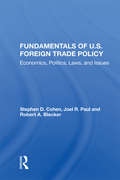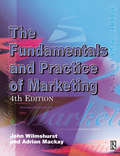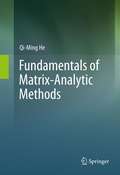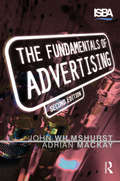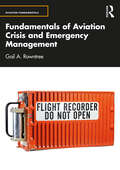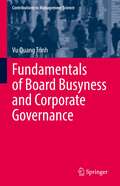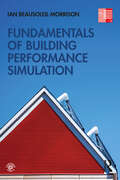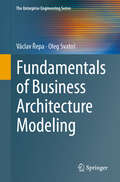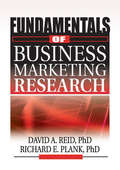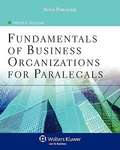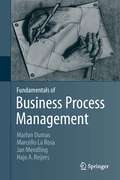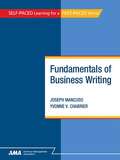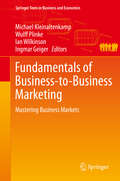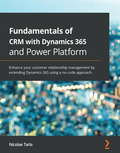- Table View
- List View
Fundamentals Of U.s. Foreign Trade Policy: Economics, Politics, Laws, And Issues
by Stephen D. CohenThis unique text integrates for the first time the three critical aspects of U.S. foreign trade policy formulation and implementation: economics, politics, and laws. In a comprehensive and nonjudgmental manner, a political scientist, an economist, and a legal scholar combine efforts to present a well-rounded view of the nature and impact of trade p
Fundamentals and Advanced Techniques in Derivatives Hedging
by Bruno Bouchard Jean-François ChassagneuxThis book covers the theory of derivatives pricing and hedging as well as techniques used in mathematical finance. The authors use a top-down approach, starting with fundamentals before moving to applications, and present theoretical developments alongside various exercises, providing many examples of practical interest. A large spectrum of concepts and mathematical tools that are usually found in separate monographs are presented here. In addition to the no-arbitrage theory in full generality, this book also explores models and practical hedging and pricing issues. Fundamentals and Advanced Techniques in Derivatives Hedging further introduces advanced methods in probability and analysis, including Malliavin calculus and the theory of viscosity solutions, as well as the recent theory of stochastic targets and its use in risk management, making it the first textbook covering this topic. Graduate students in applied mathematics with an understanding of probability theory and stochastic calculus will find this book useful to gain a deeper understanding of fundamental concepts and methods in mathematical finance.
Fundamentals and Practice of Marketing
by Adrian Mackay John WilmshurstThe fourth edition of this seminal text retains the clarity and simplicity of its predecessors in communicating the basic themes and principles of contemporary marketing. 'The Fundamentals and Practice of Marketing' has been substantially revised to take into account recent developments in the field - most particularly the changes wrought by new technology. It now follows a new structure and includes:* New chapters on: direct marketing, public relations; integrated marketing planning; wholesale and retail operations; relationship marketing; * Material on: services marketing, e-commerce, ethics and social responsibility, B2B marketing and external marketing environment* A range of new examplesThe book is accompanied by online resources for tutors which include: guidance notes on teaching methods for each chapter, case studies with suggested solutions and approaches, questions for discussion, and OHP masters.
Fundamentals at Odds? The U.S. Current Account Deficit and The Dollar *
by Gian Maria Milesi-FerrettiA report from the International Monetary Fund.
Fundamentals for Practice with High-Risk Populations
by Nancy SummersSummers' (Harrisburg Area Community College) textbook gives students in the social services fields a detailed picture of specific high-risk populations, including the unique difficulties, considerations, and issues confronting individuals in these groups and those faced by the workers who serve them. Coverage includes the definition of high risk, a theoretical means of looking at interventions, taking a sound social history when evaluation and assessment forms are not available, asking difficult questions, and case management of six groups: children, survivors of rape and domestic violence, and clients challenged by chemical dependence, impaired mental health, mental retardation, or age. Intended as a supplement to Fundamentals of Case Management Practice (Summers, 2001). Annotation c. Book News, Inc., Portland, OR (booknews.com)
Fundamentals of Matrix-Analytic Methods
by Qi-Ming HeFundamentals of Matrix-Analytic Methods targets advanced-level students in mathematics, engineering and computer science. It focuses on the fundamental parts of Matrix-Analytic Methods, Phase-Type Distributions, Markovian arrival processes and Structured Markov chains and matrix geometric solutions. New materials and techniques are presented for the first time in research and engineering design. This book emphasizes stochastic modeling by offering probabilistic interpretation and constructive proofs for Matrix-Analytic Methods. Such an approach is especially useful for engineering analysis and design. Exercises and examples are provided throughout the book.
Fundamentals of Advanced Accounting
by Joe Ben Hoyle Thomas Schaefer Timothy DoupnikThe approach used by Hoyle, Schaefer, and Doupnik Fundamentals of Advanced Accounting, 8th edition, is ideal for those schools wanting to cover 12 chapters in their Advanced Accounting course. This concise Advanced Accounting textbook allows students to think critically about accounting, just as they will do preparing for the CPA exam. The text continues to show the development of financial reporting as a product of intense and considered debate that continues today and will into the future. Students easily comprehend concepts because of the textbook's highly praised conversational tone along with the engaging, lively, and consistent writing style, all of which has contributed to making this the market-leading textbook for Advanced Accounting. The SmartBook 2.0 adaptive reading tool and algorithmic problems have been included in the new edition, along with the latest accounting standards.
Fundamentals of Advertising
by Adrian Mackay John WilmshurstThe Fundamentals of Advertising is widely recognized as the most comprehensive and informative introduction to the area for both professionals and students. The new edition has been fully revised and updated and provides a comprehensive coverage of the whole business of advertising and its associated promotional areas, including public relations, sales promotion and sponsorship. The authors use a wide range of examples to illustrate their themes and an informative series of guidelines and checklists of value not only to students but to those applying the various techniques. Topics the authors examine include: The role of the advertising agencies, Planning advertising campaigns, Setting budgets, The scope of below-the-line promotion, How advertising materials are created and produced, The issue of control in advertising, International advertising.
Fundamentals of Architectural Lighting
by Samuel MillsThe theme of this book is that light is an inseparable part of architectural design, and is intended to provide students of architecture and interior design with a graphic guideline to the fundamental role lighting plays in this process. While simple light sources may be enough to satisfy practical needs, the design process must expand beyond basic illumination. The challenge for architects and designers is the creation of luminous environments offering visual interest and a sense of well-being, while also meeting basic seeing needs. Technological advances provide opportunities for the lighting designer's creative introduction of light, and the visual and psychological perceptions of the illuminated architectural environment. Fundamentals of Architectural Lighting offers a complete comprehensive guide to the basics of lighting design, equipping students and practitioners with the tools and ideas they need to master a variety of lighting techniques. The book is extensively illustrated with over 250 illustrations to demonstrate basic principles and procedures. It is an excellent resource for anyone interested in the fundamentals of integrated lighting for architectural interior spaces.
Fundamentals of Aviation Crisis and Emergency Management (ISSN)
by Gail A. RowntreeThis book takes the topic of aviation crisis and emergency management and walks the reader through what aviation organisations must consider alongside legislation to respond fully to an aviation emergency or accident. It offers both theory and practical tips and ideas along with templates and checklists to help build confidence in how to run an aviation emergency operation. This includes timelines for activation, setting up and managing humanitarian centres and how a full aviation crisis operation runs at the site of the accident.Fundamentals of Aviation Crisis and Emergency Management is the only textbook available with all required elements laid out chronologically. The reader can plan for, train for, and exercise for a multitude of crisis examples, building both confidence and competence in managing an aviation emergency. Fundamentals of Aviation Crisis and Emergency Management includes a range of case studies and a variety of interviews with those people who have experienced an aviation crisis and deployed to it. This allows the reader to fully immerse themselves in the topic and makes the book both a textbook of key knowledge and also a book that can be read for increasing understanding of the topic. It will be essential for aviation students and professionals, disaster response organisations, and emergency planners.
Fundamentals of Aviation Operations (Aviation Fundamentals)
by Gert MeijerThis book provides a general introduction into aviation operations, covering all the relevant elements of this field and the interrelations between them. Numerous books have been written about aviation, but most are written by and for specialists, and assume a profound understanding of the fundamentals. This textbook provides the basics for understanding these fundamentals. It explains how the commercial aviation sector is structured and how technological, economic and political forces define its development and the prosperity of its players. Aviation operations have become an important field of expertise. Airlines, airports and aviation suppliers, the players in aviation, need expertise on how aircraft can be profitably exploited by connecting airports with the aim of adding value to society. This book covers all relevant aspects of aviation operations, including contemporary challenges, like capacity constraints and sustainability. This textbook delivers a fundamental understanding of the commercial aviation sector at a level ideal for first-year university students and can be a tool for lecturers in developing an aviation operations curriculum. It may also be of interest to people already employed within aviation, often specialists, seeking an accurate overview of all relevant fields of operations.
Fundamentals of Board Busyness and Corporate Governance (Contributions to Management Science)
by Vu Quang TrinhThis book delivers the essential concepts and theoretical perspectives of corporate governance and board busyness. It uses the unique context of a dual banking system to capture the potential effects of such aspects on corporate outcomes. Board busyness refers to a board with a substantial proportion of “busy” members who hold multiple directorships. In most cases, directors are “over-boarded,” which means that they hold an excessive number of seats across different boards. The busyness of individuals is gauged to infer their monitoring and recommending abilities through their involvement, efforts, knowledge, skills, and experience, and hence, their behaviour in financial contexts. Yet an assessment of board busyness and its effects is challenging and inconclusive concerning the two opposing arguments surrounding this board attribute: reputation and busyness. The book is the first to thoroughly discuss this up-to-date concept within the dual banking system, and it is designed to help new researchers in this field and students boost their research and academic careers.
Fundamentals of Building Performance Simulation
by Ian Beausoleil-MorrisonFundamentals of Building Performance Simulation pares the theory and practice of a multi-disciplinary field to the essentials for classroom learning and real-world applications. Authored by a veteran educator and researcher, this textbook equips graduate students and emerging and established professionals in engineering and architecture to predict and optimize buildings’ energy use. It employs an innovative pedagogical approach, introducing new concepts and skills through previously mastered ones and deepening understanding of familiar themes by means of new material. Covering topics from indoor airflow to the effects of the weather, the book’s 19 chapters empower learners to: Understand the models and assumptions underlying popular BPS tools Compare models, simulations, and modelling tools and make appropriate selections Recognize the effects of modelling choices and input data on simulation predictions And more. Each subject is introduced without reference to particular modelling tools, while practice problems at the end of each chapter provide hands-on experience with the tools of the reader’s choice. Curated reading lists orient beginners in a vast, cross-disciplinary literature, and the critical thinking skills stressed throughout prepare them to make contributions of their own. Fundamentals of Building Performance Simulation provides a much-needed resource for new and aspiring members of the building science community.
Fundamentals of Building Performance Simulation
by Ian Beausoleil-MorrisonFundamentals of Building Performance Simulation, Second Edition pares the theory and practice of a multi-disciplinary field to the essentials for classroom learning and real-world applications. Authored by a veteran educator and researcher, this textbook equips students and emerging and established professionals in engineering and architecture to predict and optimize building energy use. It employs an innovative pedagogical approach, introducing new concepts and skills through previously mastered ones and deepening understanding of familiar themes by means of new material.Covering topics from indoor airflow to the effects of the weather to HVAC systems, the book’s 25 chapters empower learners to: Understand the models and assumptions underlying BPS tools Compare models, simulations, and modelling tools and make appropriate selections Recognize the effects of modelling choices and input data on simulation predictions Each subject is introduced without reference to particular simulation tools, while practice problems at the end of each chapter provide hands-on experience with the tools of the reader’s choice. Curated reading lists orient beginners in a vast, cross-disciplinary literature, and the critical thinking skills stressed throughout prepare them to make contributions of their own. Fundamentals of Building Performance Simulation, Second Edition provides a much-needed resource for new and aspiring members of the building science community.The textbook will be accompanied by student and instructor digital resources including chapter introduction videos by the author, software and simulation walkthrough videos, weather data, photographs, drawings and measured data to support the culminating trials.
Fundamentals of Business
by Stephen J. Skripak(B&W) Fundamentals of Business, Second Edition (2018) is an 372-page open education resource intended to serve as a no-cost, faculty customizable primary text for one-semester undergraduate introductory business courses. It covers the following topics in business: Teamwork; economics; ethics; entrepreneurship; business ownership, management, and leadership; organizational structures and operations management; human resources and motivating employees; managing in labor union contexts; marketing and pricing strategy; hospitality and tourism, accounting and finance, and personal finances. The textbook was designed for use in Virginia Tech's Pamplin College of Business introductory level business course, MGT1104 Foundations of Business and is shared under a Creative Commons Non-Commercial ShareAlike 4.0 license. http://hdl.handle.net/10919/84848
Fundamentals of Business Architecture Modeling (The Enterprise Engineering Series)
by Václav Řepa Oleg SvatošThis textbook covers business architecture modeling in all its essential aspects. Based on the MMABP Philosophical Framework for Business System Modelling it provides a comprehensive overview of four basic dimensions of the business system model together with their essential relationships. The methods, techniques, and tools are described and explained for every model type with examples. Special attention is paid to integrating all dimensions using the Business System Consistency Framework. The book is divided into six chapters. Chapter 1 introduces business architecture and the approaches and tools to model it. MMABP is introduced with its basic principles and put in context with other approaches to business architecture modeling. Chapter 2 then deals with the modeling of a business system in terms of its objectives. The basic principles of process modeling, the distinction between global and detailed views of processes, and an approach to managing the detail of the process model in the form of four levels of process abstraction are introduced. Chapter 3 describes the modeling of a business system in terms of its underlying concepts and the business rules that apply within the modeled system. The basic principles of object modeling, the distinction between global and detailed views of objects, and the approach to capturing the object life cycles are introduced. Chapter 4 presents a simplified metamodel that describes how all models of the business system are related, and consistency rules that guide the analysts to avoid possible inconsistencies. Chapter 5 focuses on the implementation of the business system in an organization. It describes the role and specifics of its information system, explains the comprehensive procedure for building the process-driven organization, and reflects on the organizational maturity and its role in the further development of a process-driven organization. Eventually, Chapter 6 presents a complex example of the application of MMABP, including the functioning prototype of the process system. The prototype is then used to illustrate an essential difference between the conceptual and technology levels of models, and the importance of distinguishing between them. This textbook is written for students in enterprise architecture or business information systems as well as for professionals developing enterprise information systems or process-driven organizations.
Fundamentals of Business Marketing Education: A Guide for University-Level Faculty and Policymakers
by J David LichtenthalMake the most of your ability to teach business-to-business marketing! Fundamentals of Business Marketing Education: A Guide for University-Level Faculty and Policymakers examines the essential issues of teaching business-to-business marketing courses at all four university levels. An international network of educators and practitioners addresses the real concerns you have about developing a curriculum and formulating policy, taking into account the social and economic considerations you face in dealing with practical, methodological, and theoretical business marketing issues. Combining scholarly analysis with practical presentation and style, the book is the comprehensive reference you need to make sure your students have a thorough understanding of the interactive circle that connects instruction, research, and the corporate business world. Fundamentals of Business Marketing Education presents original papers that address the pedagogic and content issues you face at each level of university instruction-doctoral studies, executive education, graduate, and undergraduate studies. Each section is accompanied by scholarly commentary for added perspective, helping you to form your own style of course implementation. The book also includes a comparative review of business marketing textbooks, examining the nuts and bolts of writing for university-level instruction-content, style, textbook features, and the "street smarts" needed to deal with publishers. Topics addressed in Fundamentals of Business Marketing Education include: the status of and prospects for doctoral programs in business-to-business marketing making business marketing more prominent in master&’s programs linking content to practice in undergraduate business marketing courses the impact of alternative technologies on delivering business-to-business marketing education teaching business marketing in the 21st century a comparative review of business marketing textbooks and much more! Fundamentals of Business Marketing Education: A Guide for University-Level Faculty and Policymakers is an essential resource for educators working to confirm the importance of business education and its contribution to society. Anyone who teaches marketing-from full professor to occasional adjunct-will find this book invaluable for making the most of your ability to teach business-to-business marketing.
Fundamentals of Business Marketing Research
by J David Lichtenthal Richard E Plank David A ReidGet a thorough review of vital research issues! Fundamentals of Business Marketing Research examines recent industrial/business research, evaluates its current effectiveness, and offers suggestions for future use. This unique book includes and is based on "Business Marketing: A Twenty Year Review," a thorough study of industrial/business research from 1978-1997 with critical commentary from a distinguished panel of business academics and the response of the study's authors. The combination of critiques, insights, and viewpoints will challenge you to think beyond the traditional role of B2B marketing into a future that's anything but business as usual. Through an unusual format that gives you access to critical academic analysis, Fundamentals of Business Marketing Research presents a comprehensive review of vital research areas, including marketing to businesses/institutions/governments; buyer-seller relationships; computer use for business marketing; industrial segmentation; channel management and development; physical distribution; advertising; and public relations. The book&’s give-and-take is equally focused on areas that have traditionally received a larger share of the research effort (organizational buyer behavior, business marketing strategy and planning, industrial selling and sales management) and those that have taken a back seat in terms of research attention (computers and ethical business marketing). The original study, its criticisms, and the authors&’ subsequent assessment spotlight major themes, individual contributions, and future trends in major topic areas, including: business marketing strategy organizational buying behavior and purchasing management business marketing research methodology products/services pricing management issues distribution/logistics and supply chain management promotion Fundamentals of Business Marketing Research is equally effective as a practical guide for professionals and researchers, and as an academic text for doctoral studies.
Fundamentals of Business Organizations for Paralegals (3rd Edition)
by Deborah E. BouchouxFundamentals of Business Organizations for Paralegals, Third Edition, offers a concise treatment of all of the forms of business organizations in the United States. The author provides thorough, succinct treatment of all pertinent topics, making this book the ideal choice for instructors who teach a shorter course and need a text that covers critical topics with a more straightforward approach. Attentive To The fundamentals paralegal students need to know, this concise paperback provides: a basic and thorough understanding of all the various types of business organizations in a direct and concise format a discussion of each form of business organization, including the nature of the entity, advantages and disadvantages, formation of the entity, operation and management, transferability of ownership, dissolution, and tax consequences more in-depth treatment of Limited Liability Partnerships and Limited Liability Companies than other texts useful exhibits and charts that highlight important topics and sample forms that are integrated with the textual discussion throughout the book Internet resources in each chapter that direct readers to Internet sites that may provide additional information, forms, or agreements Key Terms defined in the margins for easy reference, practice tips in each chapter that provide pragmatic information for paralegals, lists of relevant websites and of tasks commonly performed by paralegals, and a complete glossary that provides an easy reference for terminology Case Illustrations -- brief summaries of cases that illustrate one of the concepts or topics addressed in the chapter Discussion Questions in each chapter that stimulate class discussion and ensure that students Understand The material a complete ancillary package, including an instructor's manual with a test bank and PowerPoint slides. The Instructor's Manual will also provide additional forms, such as tax forms, not included in the text New to Third Edition: each chapter includes all new discussion questions, Internet questions, and Case Illustrations Chapter 6 discusses Revised Uniform Limited Liability Company Act Chapter 10 discusses new trends in corporate governance, such as the move toward electing boards of directors by majority rather than plurality vote, The move toward eliminating staggered or classified boards of directors, new SEC rules and regulations, And The availability of proxy materials on the Internet coverage of the 2008 financial crisis Clear and To The point, Fundamentals of Business Organizations for Paralegals is an excellent, concise treatment of the basics of business organizations, providing students with a thorough understanding of essential topics.
Fundamentals of Business Process Management
by Marlon Dumas Hajo A. Reijers Jan Mendling Marcello La RosaBusiness Process Management (BPM) is the art and science of how work should be performed in an organization in order to ensure consistent outputs and to take advantage of improvement opportunities, e.g. reducing costs, execution times or error rates. Importantly, BPM is not about improving the way individual activities are performed, but rather about managing entire chains of events, activities and decisions that ultimately produce added value for an organization and its customers. This textbook encompasses the entire BPM lifecycle, from process identification to process monitoring, covering along the way process modelling, analysis, redesign and automation. Concepts, methods and tools from business management, computer science and industrial engineering are blended into one comprehensive and inter-disciplinary approach. The presentation is illustrated using the BPMN industry standard defined by the Object Management Group and widely endorsed by practitioners and vendors worldwide. In addition to explaining the relevant conceptual background, the book provides dozens of examples, more than 100 hands-on exercises - many with solutions - as well as numerous suggestions for further reading. The textbook is the result of many years of combined teaching experience of the authors, both at the undergraduate and graduate levels as well as in the context of professional training. Students and professionals from both business management and computer science will benefit from the step-by-step style of the textbook and its focus on fundamental concepts and proven methods. Lecturers will appreciate the class-tested format and the additional teaching material available on the accompanying website fundamentals-of-bpm.org.
Fundamentals of Business Process Management
by Marlon Dumas Hajo A. Reijers Jan Mendling Marcello La RosaBusiness Process Management (BPM) is the art and science of how work should be performed in an organization in order to ensure consistent outputs and to take advantage of improvement opportunities, e.g. reducing costs, execution times or error rates. Importantly, BPM is not about improving the way individual activities are performed, but rather about managing entire chains of events, activities and decisions that ultimately produce added value for an organization and its customers.This textbook encompasses the entire BPM lifecycle, from process identification to process monitoring, covering along the way process modelling, analysis, redesign and automation. Concepts, methods and tools from business management, computer science and industrial engineering are blended into one comprehensive and inter-disciplinary approach. The presentation is illustrated using the BPMN industry standard defined by the Object Management Group and widely endorsed by practitioners and vendors worldwide. In addition to explaining the relevant conceptual background, the book provides dozens of examples, more than 100 hands-on exercises – many with solutions – as well as numerous suggestions for further reading. The textbook is the result of many years of combined teaching experience of the authors, both at the undergraduate and graduate levels as well as in the context of professional training. Students and professionals from both business management and computer science will benefit from the step-by-step style of the textbook and its focus on fundamental concepts and proven methods. Lecturers will appreciate the class-tested format and the additional teaching material available on the accompanying website fundamentals-of-bpm.org.
Fundamentals of Business Writing
by Joseph C. Mancuso Yvonne V. ChabrierA ground-breaking approach to writing with a greater focus on planning and revising documents. When you complete this book, you will know how to write with clarity and style, so your ideas come across clearly and quickly. You’ll become a sharp-eyed critic, constantly spurring yourself to do better. Best of all, you’ll learn by doing—by building and evaluating your own business letter. You’ll discover how to avoid writer's block by making writing a process with a beginning, middle, and end. You will learn how to: • Sharpen your competitive edge through good, clear writing • Make sure your written words say exactly what you mean • Identify words and phrases that get in the way of clear, concise communication • Quickly analyze, organize, write, and revise any document • Use expressive words; keep sentences and paragraphs short; keep thoughts simple • Use techniques that involve the reader and create the feeling of personal communication • Format documents so they're inviting to look at and easy to read
Fundamentals of Business-to-Business Marketing
by Wulff Plinke Michael Kleinaltenkamp Ian Wilkinson Ingmar GeigerThis textbook gives a comprehensive overview of the key principles of business marketing. The reader will be introduced into methods and theories in order to understand business markets and marketing better. Not only are the principles of business marketing addressed, but also deep knowledge of organizational buying and market research on business markets. The book sets the stage for developing marketing programs for business markets in their different facets.
Fundamentals of CRM with Dynamics 365 and Power Platform: Enhance your customer relationship management by extending Dynamics 365 using a no-code approach
by Nicolae TarlaExplore the latest features of Dynamics 365 and Power Platform's out-of-the-box tools to build custom business solutions for your organization Key Features Discover impressive Dynamics 365 features to transform your business and increase productivity Leverage the platform's extensibility to meet your organizational needs Understand how Power Platform powers Dynamics 365 and enhances its integration capabilities Book Description Microsoft Dynamics 365 provides a vast array of tools and applications to meet various Customer Engagement requirements. This Customer Relationship Management (CRM) guide covers the latest advancements in Dynamics 365 and Power Platform that help organizations adapt to changing market conditions for agility and resilience. With this book, you'll explore the core platform functionality of Dynamics 365 and explore its wide range of components for transforming your business with new services and capabilities. You'll learn the basics of configuration and customization to enhance the functionality of Microsoft Dynamics 365 CRM and create solutions and custom applications by leveraging features such as apps, portals, automation, and business intelligence. As you advance, you'll understand how Power Platform drives Dynamics 365 and how various integration capabilities add value by providing a comprehensive view of data aggregated across different systems and data sources. Finally, you'll delve into core administration concepts that will help you to manage extensions added to the platform. By the end of this book, you'll have learned how to tailor Microsoft Dynamics 365 to fit your organization's requirements and tweak the platform to meet your business needs. What you will learn Get to grips with Power Platform for building and enhancing Dynamics 365 apps Integrate Dynamics 365 CRM with Microsoft 365, Azure, and other platforms Discover how you can customize existing entities and create new ones Explore various security features and grant users access to CRM data and functions Find out which CRM attributes are used to automate operations with programming Use internal and external social data to help users to make informed decisions Who this book is for This book is for customers and project stakeholders, new functional consultants, business administration users, and project managers looking to get up and running with the latest features of Dynamics 365 and Power Platform. This guide will help non-developers become acquainted with a no-code approach to customization and configuration. A basic understanding of relational data and customer management concepts will help you get the most out of this book.
Fundamentals of Corporate Communications
by David Reed Richard DolphinThe Fundamentals of Corporate Communications gives professionals and students in marketing a comprehensive and incisive overview of what modern corporate communications is, and what it can achieve. The author has drawn on extensive business experience in the area and wide ranging research in major corporations to produce an authoritative account of best practice - backed by numerous cases and examples.The book demonstrates how corporate communications affects today's marketing mix and explains how it can support wider marketing objectives. The key elements are covered in depth: * Who are the key audiences in the present business climate * The role of Corporate Image and Identity in the communications process * How communications informs and affects corporate strategy development * What are the tools of modern communications- from lobbying to brand building * Using communications in a crisis* Who should be communicator and whyThe book is both highly practical, it is grounded in real business issues, and rigorous in covering the concepts accessibly. It will be an essential text and reference for practitioners and students of marketing.
